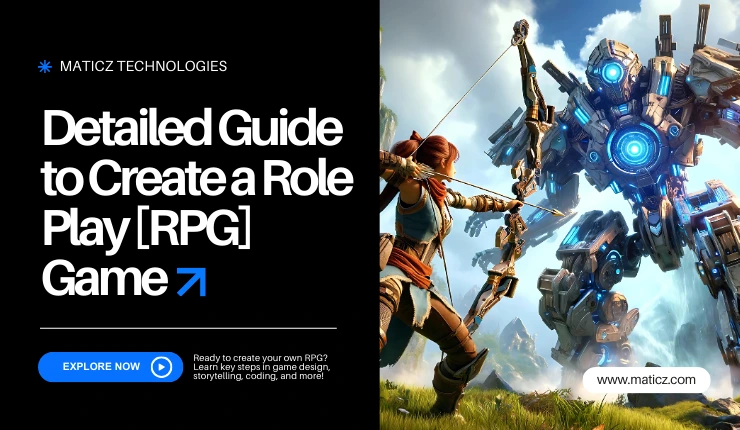Share Posts

How to Make an RPG Game: A Development Guide for 2025
46
2479
103
Role-Play Game: Interactive Story Adventure
In role-play games, players embody fictional characters in an alternate universe and lead them through adventures. They create unique characters by choosing from different classes, races, and abilities that influence the game's story and gameplay. The games involve interaction in which players direct events and make decisions about what happens next or how the story unfolds. Typical elements in most RPGs include some degree of exploration, combat, and solving of puzzles-all of which require strategic thinking and some problem-solving skills. Characters grow more powerful through gaining experience, acquiring levels, and earning advanced abilities, equipment, and skills. There is a variety of forms in which RPGs are presented, from tabletop to video games, granting deeply immersive and interactive experiences.
Why Invest in Role-Play Game Development?
Developing role-play games offers considerable potential because of their global popularity and captivating experience. Generally, RPG provides various revenue streams, including game sales, downloadable content, and in-game purchases. This genre has a huge fanbase worldwide, with established franchises and innovative newcomers gaining attention. These games frequently push technological boundaries, which attracts investors who are looking to support cutting-edge development.
Many of the RPGs in the market maintain long-term player engagement through rich storytelling and expansive words, assuring strong retention rates. The emergence of mobile gaming and the integration of AR/ VR technologies resulted in the growth of new opportunities. In addition, RPGs often benefit from cultural significance and nostalgic appeal. Overall, the market continues to expand, offering a rewarding investment potential for the future.
10 Steps to Create an RPG Game
Creating a role-playing game includes a series of creative and technical steps. Start by developing a compelling storyline, characters, and world-building elements that captivate players. Design a game system with mechanics for character progression, combat, and interactions. Craft engaging quests and challenges that align with the game's narrative. Finally, ensure the game environment is immersive, with rich visuals, sound, and fluid gameplay mechanics, offering players a dynamic, evolving experience. Here is a detailed step-by-step game development process for creating an RPG game.
1. Develop a Unique Game Concept
2. Design Engaging Characters
3. Craft Intricate Plot and Quests
4. Define Core Mechanics and Systems
5. Design Interactive Environments
6. Develop a Compelling Art Style
7. Compose an Immersive Soundtrack
8. Implement Advanced Programming Techniques
9. Conduct Thorough Play Testing
10. Plan and Execute a Successful Launch
Step 1: Develop A Unique Game Concept
Creating a unique theme can make your RPG stand out. You can blend genres for example combining science fiction and medieval fantasy. Make sure that the world buildings are rich and immersive, so deciding on the history, geography, and culture of your game world is essential.
Think about the conflicts that drive the story of your world. Detailing the information helps create a living, breathing universe. To add diversity, consider different regions' climates and ecosystems. You may want to sketch rough maps to visualize the geography. This foundation sets the stage for your narrative and gameplay.
Additionally, you should consider your world's technical constraints, ensuring the scale fits within your engine’s capabilities. One way to achieve variability could be through procedural generation. Also, define how environmental factors, such as weather and seasons, impact the gameplay mechanics.
Step 2: Design Engaging Characters
The main characters must be well-rounded and relatable. Each character should have a distinct personality and background. Non-playable characters can add depth to your world, so it's crucial to make them memorable. Give non-playable characters unique dialogue and roles, such as offering quests, secrets, or lore.
Playable characters should evolve meaningfully. Providing customization options allows players to express themselves freely. Ensure characters interact dynamically with the world, making them feel like they are part of a living environment. Realistic, engaging characters will keep players invested.
Additionally, incorporating advanced AI can make non-playable characters feel alive, with routines and reactions based on the player’s actions. Build a complex dialogue tree system with branching paths that give players a sense of real impact.
Step 3: Craft Intricate Plot And Quests
Your main plot should captivate the player from the very start and keep them hooked until the end. To diversify quest types, frameworks like Unity's Quest System Toolkit or Unreal's Dialogue System are ideal for handling branching dialogue trees and quest tracking. For procedural storytelling, consider Ink by Inkle Studios, a narrative scripting tool that integrates with both Unity and Unreal Engine.
Diversifying quest types, such as fetch quests, puzzles, and battles, will provide varied challenges for players. Quests should also challenge players in different ways. They can be used to reveal more about the world, and also include moral dilemmas to encourage thoughtful decisions.
Additionally, use scripting for conditional quests where characters and events evolve based on the player's choices. Design multi-layered quests that require exploration, puzzle-solving, and combat, using a variety of mechanics to keep things fresh. Finally, invest in the development of quest-tracking systems and journal features to help players stay on track without overwhelming them.
Step 4: Define Core Mechanics And Systems
A unique combat system can truly define your RPG. Choose between real-time, turn-based, or hybrid combat styles based on the experience you want to create. Additionally, create a progression system that feels rewarding. Skills, abilities, and leveling should significantly impact gameplay, offering meaningful choices.
Include diverse enemy types and behaviors, making combat feel dynamic. Balancing is key, so ensure that difficulty scales appropriately throughout the game. Incorporate crafting, looting, and inventory management systems to add depth. Consider adding mini-games or puzzles for variety. It’s important to establish clear rules and mechanics from the start to avoid confusion.
The core mechanics should complement the story and world, making everything feel interconnected. Use a dynamic difficulty adjustment system to personalize the challenge based on player performance. Finally, add tooltips and tutorials to help players learn how to interact with systems.
Step 5: Design Interactive Environments
Design a world map with diverse regions, each offering unique gameplay experiences. Hidden treasures and secrets will make exploration even more exciting. Ensure dynamic events and environments that react to player actions. Dungeons should provide varied challenges and rewards, adding replay value.
Use environmental storytelling to convey lore without relying solely on dialogue. Interactive objects should be integrated to add immersion and variety to gameplay. Ensure that transitions between environments are seamless, maintaining the player’s sense of immersion.
Build a real-time environmental system that reacts to player actions, such as destructible objects or weather conditions influencing gameplay. Use a Level of Detail system to optimize performance in large, open-world settings. Additionally, make sure that interaction mechanics feel user-friendly and smooth.
Step 6: Develop A Compelling Art Style
Choose an art style that fits your theme and world. Create diverse and vibrant environments to give each region its personality. Pay careful attention to color schemes and lighting, ensuring they complement the tone of each area. Visual elements should enhance storytelling, helping players feel more immersed in the world.
Incorporate animations to bring characters to life. Your art style should evolve as the game progresses, reflecting the changes in the narrative. Collaborate with artists to create cohesive visuals throughout the game. Optimizing the art assets can reduce memory usage and loading times while maintaining high-quality visuals.
Ensure the models are designed to support realistic lighting and shadows, which will enhance immersion. Consider using shaders for special effects like weather, magic, or environmental interactions. Use modular assets for dynamic world-building, ensuring variety without requiring an excessive number of unique models.
Step 7: Compose An Immersive Soundtrack
The soundtrack should enhance emotional moments and elevate the overall experience. To create contrast, use different tracks for various gameplay scenarios, such as battles and exploration. Sound effects should correspond to the player’s actions to make the world feel responsive.
Original music adds a unique flavor to your game, establishing the identity. Themes should match the tone of each environment, whether it is somber, epic, or lighthearted. Consider hiring a composer for a professional, high-quality soundtrack. Background music should support the gameplay without overwhelming it.
Additionally, sound effects should be varied and realistic, enhancing immersion. Remember proper sound design can elevate the entire experience. Implement an adaptive soundtrack that changes based on in-game events. Optimize your sound assets to ensure low latency and minimal performance impact.
Step 8: Implement Advanced Programming Techniques
Develop sophisticated AI for NPCs and enemies to make them react dynamically to player actions. Create dynamic events based on player choices that can alter the world around them. Implement seamless transitions between gameplay and story to maintain immersion.
Advanced scripting techniques can add depth to mechanics and help bring your world to life. Regularly test and debug your code to avoid issues. Use physics engines to create realistic interactions and environments. Implement machine learning algorithms to make AI behavior more unpredictable and responsive.
Create a behavior tree system to handle complex non-playable characters and enemy logic. Use dynamic event systems that trigger based on player actions, time, or environmental factors. Implement multithreading to ensure smooth performance during complex scenes or simulations.
Step-9: Conduct Thorough Play Testing
During the testing phase, use Unity's Test Framework or Unreal's Automation System for automated playtesting. Playtesting helps to identify issues related to gameplay balance, bugs, and user experience. Gather feedback from a group of testers to get a variety of perspectives. Regularly update the game based on this feedback. Prioritize fixes that will have the greatest impact on the experience.
Ensure all mechanics function as intended and provide the intended experience. Consider accessibility and inclusivity, ensuring that players of all backgrounds can enjoy the game. Use automated playtesting tools to simulate various player actions and catch issues that may not arise during manual testing.
Perform stress tests to identify potential performance problems, such as memory usage, framerate drops, or server load issues (for multiplayer). Use version control to easily manage changes and roll back quickly if a bug is introduced. Lastly, monitor playthroughs for emotional engagement, ensuring your story resonates with players.
Step-10: Plan And Execute A Successful Launch
Conduct a beta test for final adjustments before launch. Gather last-minute feedback to refine the game even further. Plan a strategic launch date to maximize visibility and reach. Develop marketing content such as trailers to build anticipation.
Create demo versions to allow potential players to try the game early. Address any major issues identified pre-launch to ensure a smooth experience. After launch, be prepared for patches and updates to address any post-launch issues. Keep engaging with your player community to foster long-term relationships.
Implement cloud-saving features for player convenience, allowing them to continue their progress across devices. Optimize the game for multiple platforms and devices to ensure accessibility for all players. Finally, consider creating systems for user-generated content to keep the game dynamic and foster community involvement.
Build Your RPG Game With Maticz
Tap into your creative potential with Maticz's RPG game development services to build immersive role-playing games. Our user-friendly platforms allow you to design engaging worlds, compelling characters, and dynamic storylines without any difficulty. Use our advanced tools for three-dimensional modeling, realistic animations, and a seamless gaming experience.
Maticz, a leading game development company, provides complete support and resources to help you realize your gaming vision. Dive into the future of game development with Maticz and fascinate your audience with unique creations. Ready to set out on your gaming adventure? Let Maticz be your guide!
Tap Into the Future
The latest insights, posts, and project updates - straight to your inbox.



